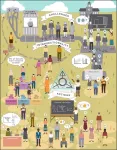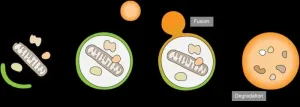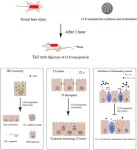(Press-News.org) A group of 24 transgender (and/or family members of transgender) scientists describe what it’s like to be a transgender person in STEMM. In a commentary publishing on March 14 in the journal Cell, they discuss the historical origins of trans marginalization, explain how this affects trans people’s careers in science and medicine, and lay out actions that cisgender individuals and institutions can take to support trans people in STEMM.
This first-of-its-kind commentary appears in a sex and gender focus issue of Cell, covering topics such as gender equity, the history of sex and gender research, and how we can improve the quality of research going forward by using more rigorous and precise sex-related variables.
“I hope that trans scientists can see this piece as a beacon of hope,” says neuroscientist and commentary author Dori Grijseels of the Max Planck Institute for Brain Research. “It can be incredibly isolating to be a trans scientist, especially in particularly hostile places, but I hope that this commentary can give a sense of community to those scientists.”
Currently, anti-trans legislation rooted in anti-scientific transphobic arguments enable these hostile and unwelcoming environments. “By standing up against this, scientists not only play an important role in trans liberation, but also scientific integrity and public trust in science,” says Grijseels.
The challenges trans people face inhibit their involvement in science and the advancement of their careers. “Legal and material precarity puts educational attainment and a productive research career, already a challenge for early career researchers, further out of reach for trans people,” write the authors.
Trans people are more likely to face harassment and discrimination in society and the workplace. They face more scrutiny to uphold what is considered “professional” dress and behavior. “Any way a trans person dresses or acts is automatically taken as a statement that is highly scrutinized, in a way that a majoritarian cis male person won’t necessarily have to expect,” says evolutionary biologist and commentary author Jess F. McLaughlin of the University of Massachusetts Amherst. “It forces us to always be hypervigilant about our own presentation of ourselves in public, which is exhausting and very othering to deal with daily.”
“These expectations punish individuals who do not conform to a narrowly defined set of behaviors,” write the authors. “Controlling what is ‘acceptable’ gendered behavior or expression in the workplace marginalizes trans people, as well as cis people with nonconforming gender expression.”
“Appeals to professionalism have greater consequences for people with intersecting marginalized identities, such as for trans women of color, who face additional, uniquely racialized pressures to perform femininity.”
Finally, the authors outline what cis researchers can do to help their trans colleagues. “Individual actions can be distilled into three key components: showing respect to trans colleagues and students without singling them out, educating oneself and others, and utilizing one’s privilege and influence to advocate for institutional and political change,” write the authors.
“While it’s natural to feel hesitant about potentially making mistakes while trying to help, the risk of inaction—fueled by a fear of making mistakes—is far greater than the risk of attempting to make a positive change,” says neuroscientist and commentary author Evyn S. Dickinson of Yale University.
The burden of making these changes cannot fall solely on trans researchers. These changes will benefit the entire scientific community, write the authors. “Without sustained action by cis colleagues, achieving inclusion and equity becomes the de facto responsibility of those who are already burdened and marginalized.”
“When cis and trans people alike challenge sex and gender essentialism, we enshrine bodily autonomy and intellectual freedom. When we build institutions and systems to support all who contribute, we move to rectify scientific inequity and injustice.”
###
Cell, Aghi et al. “Rigorous science demands support of transgender scientists” https://cell.com/cell/fulltext/S0092-8674(24)00187-9
Cell (@CellCellPress), the flagship journal of Cell Press, is a bimonthly journal that publishes findings of unusual significance in any area of experimental biology, including but not limited to cell biology, molecular biology, neuroscience, immunology, virology and microbiology, cancer, human genetics, systems biology, signaling, and disease mechanisms and therapeutics. Visit http://www.cell.com/cell. To receive Cell Press media alerts, contact press@cell.com.
END
Contrary to common belief, not all vertebrates regulate their sleep-wake rhythm in the same way. University of Basel researchers have discovered that some fish – unlike humans – do not need orexin to stay awake. This molecule was thought to be necessary for normal wake and sleep rhythms in vertebrates. Humans without orexin suffer from narcolepsy.
Until recently, it was assumed that vertebrates share similar mechanisms controlling sleep behavior. That's why researchers have been using fish in the past 20 years as a model organism to study sleep ...
After the egg has been fertilized by a sperm, the surrounding egg coat tightens, mechanically preventing the entry of additional sperm and the ensuing death of the embryo. This is according to a new study led by researchers at Karolinska Institutet and published in the journal Cell. The work also explains how mutations in egg coat proteins can cause female infertility and may eventually lead to new contraceptive methods.
Fertilization in mammals begins when a sperm attaches to the egg coat, a filamentous extracellular envelope that sperm must penetrate ...
About The Study: Teen pregnancy was associated with future premature mortality in this study of 2.2 million female teenagers. It should be assessed whether supports for female teenagers who experience a pregnancy can enhance the prevention of subsequent premature mortality in young and middle adulthood.
Authors: Joel G. Ray, M.D., M.Sc., of the University of Toronto, is the corresponding author.
To access the embargoed study: Visit our For The Media website at this link https://media.jamanetwork.com/
(doi:10.1001/jamanetworkopen.2024.1833)
Editor’s Note: Please see the article for additional information, including other authors, author contributions ...
About The Study: In this study of partners and adult children of stroke survivors, risks of several mental health conditions and self-harm or suicide were moderately higher compared with the general population and, to a lesser extent, partners and adult children of heart attack survivors. These findings highlight the potential consequences of stroke among family members, particularly partners, and its findings may possibly serve as a quantitative foundation for the development of future stroke rehabilitation services.
Authors: Nils Skajaa, Ph.D., of Aarhus University Hospital in Aarhus, Denmark, is the corresponding author.
To ...
When it comes to nurturing their young, mother chimpanzees go the extra mile, according to a new study. Using 10 years of observational data on wild chimpanzees, researchers found that while adults often play, and young chimps play a lot, when food gets scarce, the adults put mutual play aside and focus on survival.
But in the meantime, mother chimps continue to be their offspring’s primary playmate, tickling, chasing, playing ‘airplane’. That suggests the mother chimps take on an indispensable role ...
It’s no secret that smoking is extremely detrimental to health. Tobacco smoke contains thousands of chemicals, including carcinogens, increasing the risk of cancer, cardiovascular and respiratory diseases.
A new study from the University of Chicago analyzed data from more than 900 samples of nine different human tissue types to understand just how deep the cellular and genetic damage from smoking goes. The research team generated epigenetic data to assess the effects of smoking on DNA methylation, or genetic locations where a handful ...
The pregnancy and post-partum experience is stressful, but for pregnant adolescents the barriers to accessing supportive care can have fatal consequences.
A recent study from The Hospital for Sick Children (SickKids) identified that compared with those who had no teen pregnancy, teenagers in Ontario who experienced a pregnancy were at a 50 per cent higher risk of premature death before the age of 31. This risk was even higher for people who had two or more teen pregnancies and amongst those who were pregnant before 16 years of age.
Published in JAMA Network Open, the study also found that ...
Researchers from Tokyo Medical and Dental University (TMDU) uncover the specific protein interactions needed for cells to break down and remove damaged mitochondria
Tokyo, Japan – Autophagy is a process used by cells as a recycling system to transport and break down organelles and other cytosolic components, which become enveloped in a membrane called the autophagosome (Fig 1). When this involves the removal of damaged mitochondria, commonly called the “powerhouse” of the cell, it is known as mitophagy. In a recent article ...
Achille Mbembe is research professor of history and politics at the Wits Institute for Social and Economic Research, at the University of the Witwatersrand, Johannesburg. He will receive the award of NOK 6,000,000 (approx. EUR 525,000) during a 6 June ceremony at the University of Bergen, Norway.
Mbembe is one of the most read and cited scholars from the African continent and receives the prize for his pioneering research in African history, postcolonial studies, humanities, and social science over four decades. ...
A research has developed a new nanoparticle treatment that significantly improves outcomes for severe burn-induced intestinal barrier disruption. The study introduces Luminol-conjugated cyclodextrin (LCD) nanoparticles, offering a promising therapeutic intervention for one of the most critical complications following severe burn injuries.
Severe burns can cause critical issues, including deep tissue damage and increased risk of fatal conditions like sepsis and organ failure. A major concern is the disruption of the intestinal barrier, leading to inflammation and systemic ...






